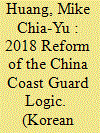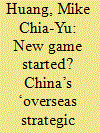| Srl | Item |
| 1 |
ID:
167951


|
|
|
|
|
| Summary/Abstract |
In June 2018, the Chinese government initiated a new round of reforms to reshuffle
the leadership of the China Coast Guard (CCG) so as to better administer the
country’s blue territory. In contrast to the 2013 structural reform of the Chinese
government which created the CCG and made it part of the State Oceanic
Administration, a sub-ministerial organ of the Chinese State Council, the 2018
reform placed the agency under direct command of the Communist Party’s Central
Military Commission. This paper argues that the CCG today has been a formidable
maritime giant and acquired a fair ability to coordinate its patrol operations with
other agencies in recent years. In particular, the maritime law enforcement force
has been made more militarized given its close association with the Chinese
Navy. Nonetheless, despite the notable performance the CCG has made, it still
faces problems of unclear legal status and weak airborne surveillance capabilities,
keeping its institutional reform far from full completion. Moreover, a more
powerful coast guard force can on the one hand facilitate Beijing’s aim to become
a great maritime power but on the other hand lead to more security challenges as a
harsher maritime contest between China and its strategic competitors is likely to be
witnessed in the near future.
|
|
|
|
|
|
|
|
|
|
|
|
|
|
|
|
| 2 |
ID:
160495


|
|
|
|
|
| Summary/Abstract |
China’s port facility construction projects in the Indian Ocean (IO) region, particularly those in Gwadar and Djibouti, have led to a heated debate among strategists over whether the country has been carrying out a ‘string of pearls’ strategy, an alleged Chinese scheme to challenge America’s military predominance in South Asia. Although Beijing has denied the existence of such a strategy, it has enhanced its strategic ties with littoral countries in the IO region over the past few years. This article discusses the evolution of Beijing’s IO strategy and examines the nature of these Chinese port projects. It argues that rather than simply copying the American model of developing military bases overseas, China has been deliberating a more sophisticated plan for its physical presence there—creating a new set of ‘overseas strategic pivots’. These ‘pivots’ are designed to help Beijing sustain its anti-piracy campaign and serve as forward stations for the transportation of China’s imported energy and merchandise while, with a relatively low-key stance, reducing any unnecessary opposing actions by rival powers. In addition, their political and economic functions are to a certain extent greater than their military functions despite the fact that they appear to be military bases. More importantly, these ‘pivots’ can help China create closer partnerships with littoral governments in the IO region, which suggests that the country is trying to create a friendly international environment favouring its plan to step into the global maritime domain.
|
|
|
|
|
|
|
|
|
|
|
|
|
|
|
|